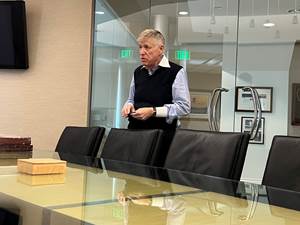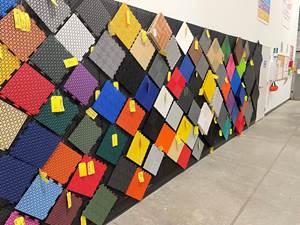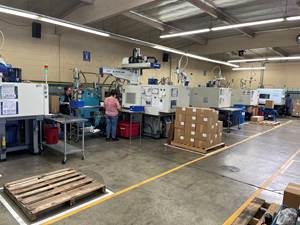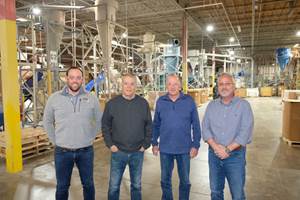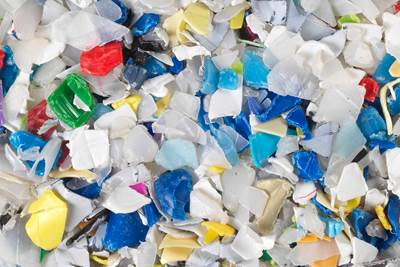Inside the Florida Recycler Taking on NPE’s 100% Scrap Reuse Goal
Hundreds of tons of demonstration products will be created this week. Commercial Plastics Recycling is striving to recycle ALL of it.
Successful recycling businesses must find not one but a variety of niches of opportunity and have flexibility to adjust as those opportunities shift. To execute successfully on a variety of operations, it’s helpful to have a team that brings a diverse set of skills to the table. Ben Benvenuti, CEO at Tampa, Florida-based Commercial Plastics Recycling Inc. (CPR), has assembled such a team.
Building a Customer Base in Regrind and Off-Prime Resin
Beginning with a small office and a 7,500-square-foot warehouse, Benvenuti started CPR in 1996. The office was 15 minutes away from the warehouse, so in those early days he was driving back and forth, making phone calls from the office and commuting to the warehouse to receive and repackage material.
Benvenuti attributes the success of the venture to customer focus and delivering on commitments. That can mean something different for each relationship. “It's a matter of understanding the client’s needs — and whether they are a supplier or a customer, they are a client, and we have to satisfy them. I try to find that point that makes them happy,” Benvenuti says.
Sometimes, that’s as simple as paying suppliers promptly, every time. “Some people want to squeeze every penny, others want to know that they can depend on you to provide the very best customer service,” Benvenuti adds. “Everyone wants to be paid on time.”
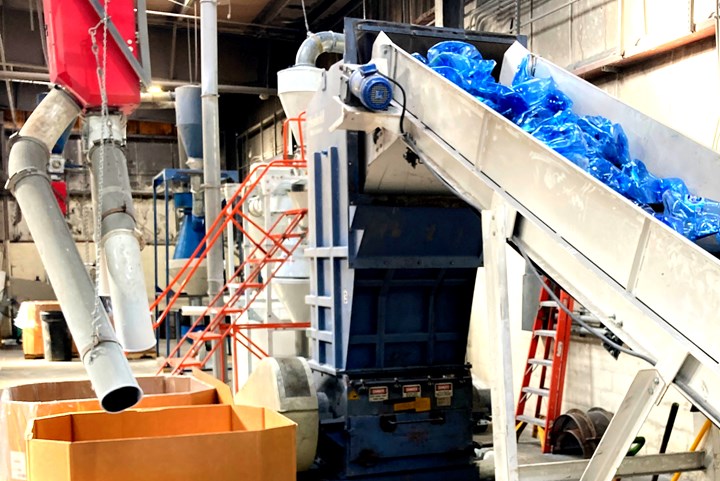
Five-gallon water jugs being recycled at CPR, while a Bunting metal detection system rejects any metallic contamination.
Source: Matt Stonecash
It was only six months before business expanded and CPR was able to move to a new facility with an office. Today, CPR has additional locations in North Carolina and Mississippi. It has also become an international business, supplying about 10% of its product to customers in Central and South America, and China.
A Versatile Approach to Processing and Distribution
The operation of a plastics recycling facility defies the common narrative of monotony and repetition in manufacturing. This is especially true at CPR, where material resin types, product format and purity change continually, requiring constant adaptation. Materials often arrive with unwanted contaminating items, which must be sorted out by hand at receipt. Large scrap of awkward shapes and sizes must be cut down using hand tools to something that can fit into a shredder. CPR also maintains its own shop, enabling blades to be sharpened on-site, thereby reducing turnaround time.
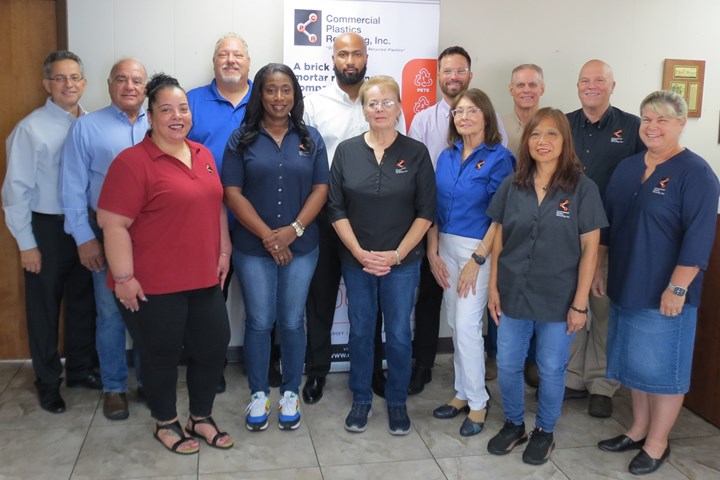
CPR staff bring a wide range of talents to their work. From left to right, Tampa location staff members: Gustavo Morales, Ben Benvenuti, Bernadette Billups, Dave Hovey, Stephanie Lewis, Daniel Resil, Donna Baum, Ryan Brodowski, Eva Hernandez, Mike Grissom, Helen Iao, Jeff Barksdale, and Pamela Morales. Photo Credit: CPR Inc.
CPR’s operations rely on flexibility and a variety of talents from its employees, in the sales and purchasing office in addition to out on the processing floor. International business, for example, is conducted in Spanish by Eva Hernandez and in Mandarin and Cantonese by Helen Iao.
This flexibility helps CPR pivot when market conditions change, by adapting to higher prices in the U.S. or abroad, for instance. “I know when I drive in and see the gas pump if we are going to have a tough time, because the price of oil is tied to the price of plastic,” Benvenuti says.
CPR is both a redistributor of materials like off-grade resins from major producers, and a recycler of industrial and construction scrap materials. As a recycler, CPR focuses on postindustrial materials and construction waste, specializing in size reduction.
Two large pipe shredders, supplied by Genox USA and Zerma, can handle pipes up to four feet in diameter and 20 feet in length. By investing in a second shredder, CPR was able to dedicate one to process PVC, eliminating the need for meticulous cleaning before changing materials. “It would be four or five days to break down every piece of equipment piping, every blade had to be removed and cleaned, because just a little bit of PVC in the HDPE would be disastrous,” Benvenuti recalls.
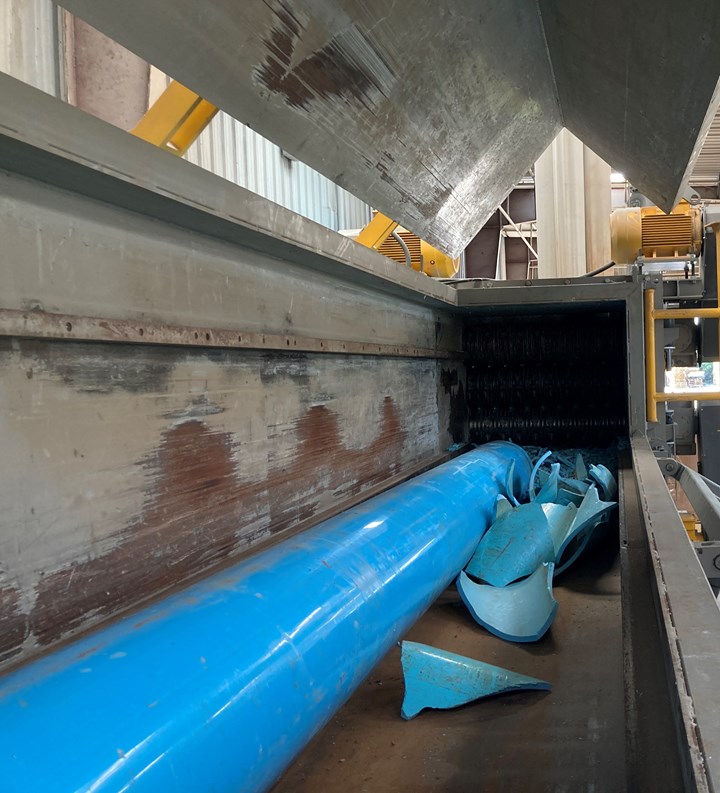
PVC pipe is processed at CPR, with a large four-rotor Genox USA shredder. Photo Credit: Matt Stonecash

A massive HDPE pipe about to be loaded into CPR’s Zerma 1500 FRS pipe shredder. Photo Credit: Matt Stonecash
In addition to pipe and other construction scrap, CPR’s shredding, grinding and pulverizing equipment processes a wide variety of industrial scrap, including roll stock, containers, caps and other defective or excess product from converters.
Producers are another source of material for CPR, including some of the largest chemical companies in the world. Offgrade resin intended for major convertors can be less than perfect for a demanding food grade application, but still have significant value. For this reason, resin producers will sell off-prime resin to CPR, and CPR finds customers for it. Producers also sell plant scrap in the form of purge. “A 30-yard dumpster will have one solid block of purge, and it’ll be dumped out on a slab. We break it up, shred it, grind it and find a home for it,” Benvenuti says.
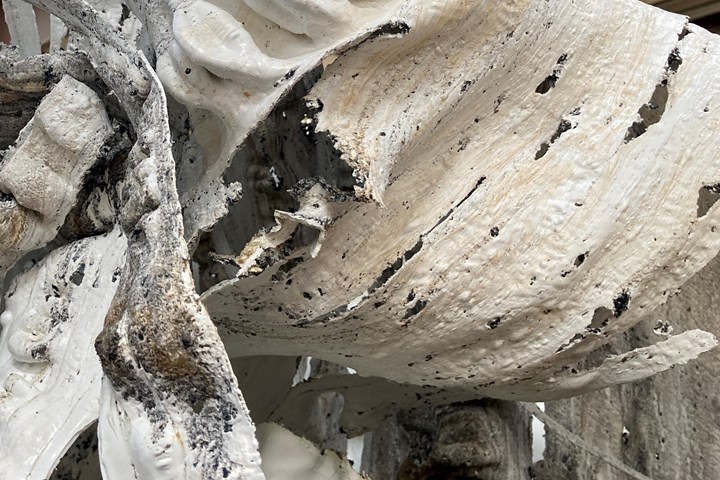
Purge material becomes feedstock for CPR.Photo Credit: Matt Stonecash
With the variety of materials coming in from different sources, it’s important to ensure everything is well characterized and tracked. Each box is given a six-digit number. If the material is not well characterized by the supplier, CPR will perform flake sink/float and melt flow testing at its lab in Tampa. Data is managed by Cietrade software, providing visibility across the three facilities. Bags of sample material from each shipment are stored for 30-60 days.
“If there is a claim — and there shouldn’t be because we have clean regrind — we can go back and see what grinder it ran on, what shift, what personnel, to narrow down exactly what happened,” says Ryan Brodowski, who manages quality control for CPR, in addition to working in sales and purchasing.
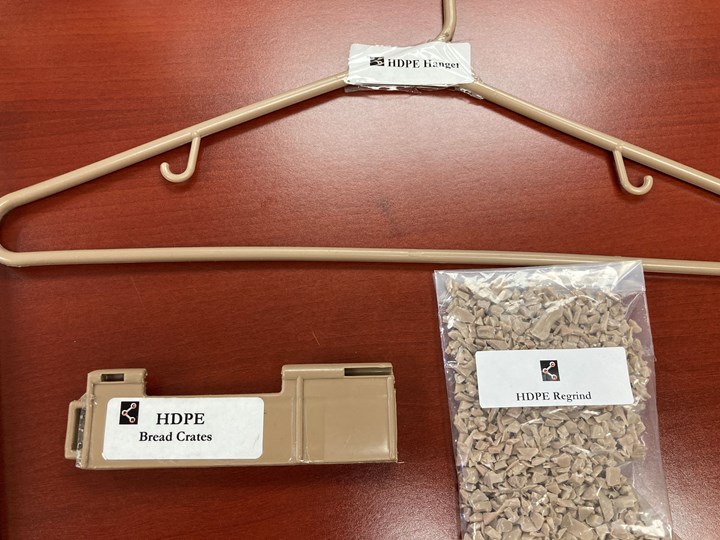
HDPE bread crates recycled by CPR into regrind which is directly molded by a customer into clothes hangers in the same color, an example of the right application enabling recycling efficiency. Photo Credit: Matt Stonecash
NPE2024: A Unique Recycling and Logistical Challenge
Every three years, CPR gets the opportunity to demonstrate their know-how on a very big stage, the Orange County Convention Center in Orlando, Florida, during this week’s NPE2024. CPR is coordinating recycling for all the plastic products created during live demonstrations on the trade show floor.
CPR began working on recycling for NPE with the Plastics Industry Association (PLASTICS) in 2015. CPR shipped 48 truckloads of demo products from the convention center back to Tampa for size reduction.
“NPE is always a great place to bring new people. We don’t have an education system that shows manufacturing to students, not nearly as much as it should.”
“The cost of transporting air just kills you,” Benvenuti says, referring to the low density of the bins of plastic parts that were trucked back to Tampa that first year. Learning from the experience, CPR came up with a new plan, which involved partnering with equipment manufacturer WEIMA. WEIMA sets up grinding equipment at the convention center, making it possible to begin the recycling process on-site.
Now that WEIMA has been brought into the partnership, the process is much more efficient. Instead of shipping boxes of recyclables that may weigh as little as 200 pounds, they are now moving 1,000-pound boxes of regrind, thereby dramatically reducing shipping costs. “We’re learning every year we do it,” Benvenuti says.
In 2018, the last year in which the show was held, 535 tons of plastic waste were diverted, about 89% of the total amount produced at the show. For NPE2024 the sights are set even higher, with CPR, WEIMA and PLASTICS aiming for 100%. Conair has also joined the effort, and is providing on-site grinding services.
NPE2024 kicked off this morning, May 6, but it began last week for many, including CPR. As exhibitors set up their demonstrations, they tried things out before the audience arrives. That means making parts, so CPR has already started supplying and collecting bins full of parts, even as other exhibitors were still moving their equipment into the million square feet of exhibit space.
Of course, the primary objective for exhibitors at NPE2024 will be to show what they can achieve, that can mean turning out parts quickly and complex designs. But sometimes adjustments can be made to a demo product that eases recycling.
Milacron is exhibiting at NPE2024, and spoke with Gustavo Morales, president at CPR, about their plans for a molding demonstration. It involved molding a bucket with a metal handle. “I said you can make that, not a problem, but we will have to bring it back to Tampa, and that is going to mean more trucking, more manpower,” Morales says. Learning this, Milacron decided to make an all-HDPE bucket, without a handle, to facilitate the recycling process.
Exhibitors are running their equipment at high rates for relatively short periods of time, so bins will fill up fast and needs will shift as each show day progresses. It all takes a lot of coordination and some extra people power. CPR brought in 60 temporary workers, along with 20 of its own staff to lead the effort.
In part, CPR staff is here to coordinate material management from all the demonstrations, in a sense giving their own demonstration of their ability to efficiently manage the flow of products. But, like thousands of other attendees, they are also here to learn.
“NPE is always a great place to bring new people. We don’t have an education system that shows manufacturing to students, not nearly as much as it should. When I hire people, they have no clue how parts are made, how pipe is made,” Benvenuti says.
Even Benvenuti himself, who studied marketing in college, knew little about plastic processing before entering the recycling business. He recalls, “I went to work for a guy and he tells me ‘We’re trying to buy film.’ I said ‘Film? Like movie film?’ It was a learning experience, and that got me excited about recycling.”
In addition to educational opportunities, the show offers a chance to meet with business associates. Many of CPR’s suppliers and customers are among the 55,000-plus attendees.
“It also gives us a chance to see what’s new in the marketplace. If you’re not staying up with what’s going on, you’re falling behind,” Benvenuti says.
Related Content
US Merchants Makes its Mark in Injection Molding
In less than a decade in injection molding, US Merchants has acquired hundreds of machines spread across facilities in California, Texas, Virginia and Arizona, with even more growth coming.
Read MoreInjection Molder Bases Company Culture on Employee Empowerment
After more than two decades in the industry, Rodney Davenport was given the opportunity to create an injection molding operation in his own vision, and — in keeping with the product he was making — to do so from the ground up.
Read MoreBack in the Family Business
In its 45th year, Precision Molded Plastics has carved out a technology and market niche, growing not just when opportunities arise but when they make sense, after its leader changed careers to keep the family business from changing hands.
Read MoreEvolving Opportunities for Ambitious Plastics Recycler
St. Joseph Plastics grew from a simple grinding operation and now pursues growing markets in recycled PP, food-grade recycled materials, and customized post-industrial and post-consumer compounds.
Read MoreRead Next
Looking to Run PCR on a Single Screw? Here’s What to Keep in Mind
Just drop it in and mix it up? Sorry, there’s a lot more to it than that. Here is some of what you need to consider.
Read MorePeople 4.0 – How to Get Buy-In from Your Staff for Industry 4.0 Systems
Implementing a production monitoring system as the foundation of a ‘smart factory’ is about integrating people with new technology as much as it is about integrating machines and computers. Here are tips from a company that has gone through the process.
Read MoreSee Recyclers Close the Loop on Trade Show Production Scrap at NPE2024
A collaboration between show organizer PLASTICS, recycler CPR and size reduction experts WEIMA and Conair recovered and recycled all production scrap at NPE2024.
Read More







 NPE Featured Exhibitors In Recycling Program
NPE Featured Exhibitors In Recycling Program
